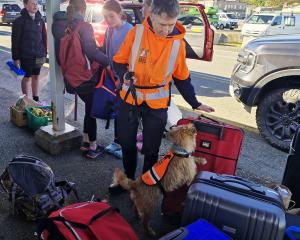
The beam is part of research happening at the MetService site near the Invercargill Airport to gather information about how aerosols impact the atmosphere.
The goSouth-2 research project is a joint venture between German and New Zealand institutions.
The German partners are the Meteorological Institute of the University of Leipzig and the Leibniz Institute for Tropospheric Research (TROPOS), and from New Zealand MetService, the University of Canterbury, and The Air Quality Collective.
Five TROPOS staff are setting up equipment at the MetService site ready for the opening of the project on September 3.
TROPOS researcher Patric Seifert said aerosols — tiny airborne particles — entered the atmosphere from many sources on the sea and land.
Particles included salt, dust, pollen and those from smoke or volcanoes.
The particles were essential for cloud formation as they acted as nuclei, or something for the cloud particles to attach to.
"The less aerosol particles are available, the less cloud particles can form, and vice-versa," Dr Seifert said.
The southern tip of New Zealand at the northern edge of the Southern Ocean was a unique place to study the relationships between aerosols and clouds, he said.
This was because the atmosphere in this region could be very clean when air masses approached from the Antarctic. However, the opposite was true when the continental air masses arrived from Australia.
Studying the differences between the aerosol content in each air mass would help the researchers better understand how clouds responded to changes in aerosol levels, he said.
Atmospheric and climate models were still less accurate at simulating clouds over the Southern Ocean compared with the northern hemisphere, he said.
Scientists think the difference in aerosol levels between the hemispheres may explain why the models perform differently.
There is more data collected about the northern hemisphere atmosphere, which is more polluted.
Invercargill was also a good place to set up the research because the logistical support for running the equipment and to accommodate staff was available, he said.
MetService already ran important observations at the site, including long-term records of weather balloon soundings, precipitation observations and solar and thermal radiation measurements, he said.
All the information-gathering instruments were land-based, but residents might see a green laser beam in the sky near Invercargill Airport.
"Our lidar [light detection and ranging] systems emit laser pulses to investigate the aerosols."
The beam was fixed, and airport staff had been told of its presence in the sky, he said.
Researchers would also use radar systems to detect and study clouds and precipitation.
TROPOS team members will be on site for 18 months, but a group of about 15 will be analysing the data in Germany.
In 2022, the goSouth-1, a month-long study with less equipment, was completed at Pahia, 50km from Invercargill.












